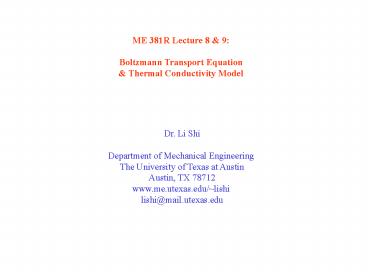ME 381R Lecture 8 - PowerPoint PPT Presentation
1 / 5
Title:
ME 381R Lecture 8
Description:
Relaxation Time Approximation. t. Equilibrium Distribution: ... Relaxation time. Non-equilibrium, e.g. in a high electric field or temperature gradient: ... – PowerPoint PPT presentation
Number of Views:65
Avg rating:3.0/5.0
Title: ME 381R Lecture 8
1
ME 381R Lecture 8 9 Boltzmann Transport
Equation Thermal Conductivity Model
Dr. Li Shi Department of Mechanical Engineering
The University of Texas at Austin Austin, TX
78712 www.me.utexas.edu/lishi lishi_at_mail.utexas.
edu
2
Drawbacks of Kinetic Theory
- Assumes single particle velocity and single mean
free - path or mean free time.
- Breaks down when, vg(w) or t(w)
- Assumes local thermodynamics equilibrium f
f(T) - Breaks down when L ? ? t ? t
- Cannot handle non-equilibrium problems
- Short pulse laser interactions
- High electric field transport in devices
- Cannot handle wave effects
- Interference, diffraction, tunneling
3
Boltzmann Transport Equation for Particle
Transport
Distribution Function of Particles f
f(r,p,t) --probability of particle occupation of
momentum p at location r and time t
Equilibrium Distribution f0, i.e. Fermi-Dirac
for electrons, Bose-Einstein for phonons, Plank
for photons, etc.
Non-equilibrium, e.g. in a high electric field or
temperature gradient
Relaxation Time Approximation
t
Relaxation time
4
Energy Flux
q
v
Energy flux in terms of particle flux carrying
energy
dk
q
k
f
Vector
Integrate over all the solid angle
Scalar
Integrate over energy instead of momentum
Density of States of phonon modes between e
and e de
5
Quasi-equilibrium Condition
BTE Solution
Quasi-equilibrium
Direction x is chosen to in the direction of q
Energy Flux
Fourier Law of Heat Conduction
t(e) can be treated using Callaway (Phys. Rev.
113, 1046) or Holland model (Phys. Rev., 134,
A471-A480)
If v and t are independent of particle energy, e,
then ?
Kinetic theory































